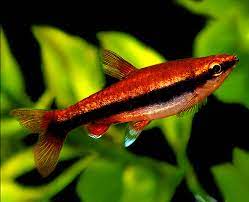The Coral Red Pencilfish is one of the most attractive species of pencilfish.
These fish are relatively new to the hobby and was only accurately described in 2001.
It was recognised and named by Martin Mortenthaler, the proprietor of the Austrian export company, Aquarium Rio Momon, in 2000.
This pretty small fish was first named as a sub-species of the Dwarf Pencilfish but then shortly after was recognized as its own separate species.
The Coral Red Pencil fish is a beautiful, active and friendly fish, it is quite small but makes a great addition to the community tank when in a group.
This species has a coral red colouration covering its entire body and fins with two sharp horizontal black stripes to contrast.
| Quick Facts | |
| Scientific Name | Nannostomus mortenthaleri |
| Other Names | Red Arc Pencilfish, Peruvian Red Pencilfish, Ruby Red Pencilfish. |
| Family | Lebiasinidae |
| Genus | Nannostomus |
| Origins | Peru, South America |
| Temperament | Peaceful |
| Aquarium Level | Middle - Top |
| Difficulty | Beginner - Intermediate |
| Shoaling | No |
| Best kept as | Groups 5+ |
| Diet | Omnivore |
| Reproduction | Egg-Layer |
| Lifespan | up to 5 year |
| Water Parameters | |
| Water Type | Freshwater |
| Temperature | 77.5 - 80.2 ℉ (25.3 - 26.8 ℃) |
| PH | 4.0 - 7.0 |
| GH | 1 - 12 |
| TDS | 18 - 90 |
Habitat
The Coral Red Pencilfish comes from the backwaters, small tributaries and swamplands of Loreto, Province of Maynas, the Rio Nanay at the village of Alvarenga, and appears endemic to the Nanay basin in Loreto Department, Peru, in South America. They have also been found in the Rio Tigre system a little further west.
They inhabit very soft acidic water that is still and sluggish and covered in dense vegetation and a vast quantity of leaf litter and wood which decay leaving a tea-coloured tint.
Diet & Feeding
In the aquarium, Pencilfish are not fussy eaters and will generally eat all kinds of prepared foods including micropellets, freeze-dried food and most flake foods.
To give these fish the best colour and to keep them at optimal health you can feed them with or live or frozen foods such as bloodworm, mosquito larvae and brine shrimp.
Sexual Dimorphism
Adult males are noticeably less heavy built and far more vibrant in colour than females, and they display a white marking at the anterior dorsal-fin base from a young age.
Another way to sex this species is to watch their behaviour. Males will frequently present and nip at each other while the females are very docile.
Breeding
It is possible to breed Coral Red pencil fish, but it can be quite challenging for the lesser experienced hobbyist.
For this to succeed, you will need a separate tank, the water should be mature and have a low PH, and the lights will need to be relatively dim.
Make sure you have plenty of fine-leaved plants if these are unavailable a spawning mop will be adequate.
The substrate should have marbles or equivalent, such as pebbles or small rocks.
You will also need gentle air-driven filtration.
Once the pencil fish are ready to spawn, they will swim next to each other, and the male will bump the female's abdomen, and the eggs will be fertilised. The female will drop a few eggs at a time which will fall into the plants or the substrate until she is spent of eggs.
After all the eggs have been laid, it is advisable to remove the parents straight away as they are known to be voracious egg eaters if given the opportunity.


